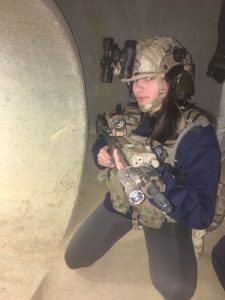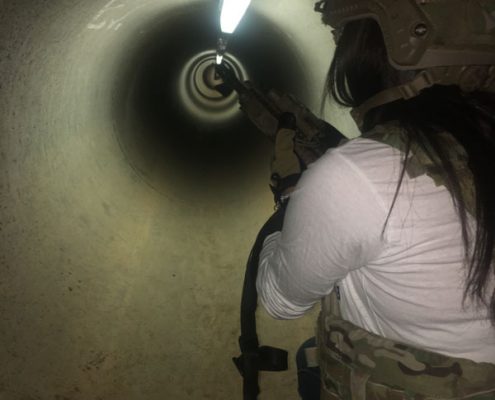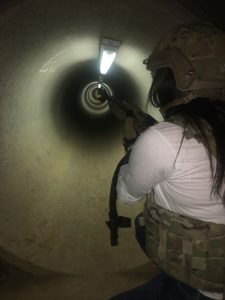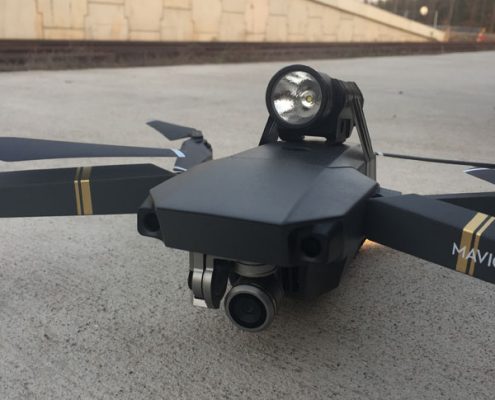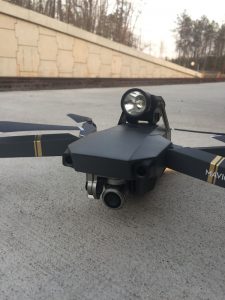75th Ranger Regiment sponsor, Giavanna Verdi, Jared Michael Zurn, Marshall Grimard, Joshua Talley, and Cassandra Hagstoz
Hacking 4 Defense – Deep Clearance at the JMU X-Labs
In 2016, JMU student Jack O’Neill listened to serial entrepreneur Steve Blank give a talk about a program called Hacking 4 Defense where graduate students solve complex U.S. Department of Defense problems. Less than a year later, with support from Stanford University, 4-VA and JMU, Jack’s team launched the first undergraduate Hacking 4 Defense program in the nation at JMU.
The spring 2017 class formed cross-disciplinary teams of students from a broad spectrum of departments: biology, communications, computer science, engineering, history, intelligence analysis, nursing, and public policy. One group of five students worked on a project called Deep Clearance with the objective of quickly mapping out any unknown cover—such as a cave—to determine its security before entering.
The students interviewed sponsors, experts, and end users every week to explore the problem and clarify the definition of a successful solution. Key partners included the 75th Ranger Regiment, DARPA contractors and the U.S. Special Operations Command (USSOCOM).
“Saving lives is our true mission for this project,” affirmed student Marshall Grimard.
Although the team was certain that drones played a crucial part in the solution, drones lose GPS connectivity soon after entering caves. Reality set in as they also discovered the need to account for compactibility, temperature, battery life, battery weight, sensor accuracy, dust and the possibility of sound compromising the Rangers’ position.
A visit to Fort A.P. Hill really hit home when they met some of the soldiers firsthand. At the training center they strapped on army gear, crawled through tunnels and learned more about the people they were helping. “Saving lives is our true mission for this project,” affirmed Marshall Grimard. The 5-hour roundtrip journey solidified the connection between the students who’ve bonded through their work together.
Using the Lean Startup methodology, including tools like customer value proposition, students were steeped in intensive hands-on learning. Every week the Deep Clearance team presented their findings and adapted their minimal viable product (MVP) as they deepened their understanding of the problem and potential solutions.
“I wish education was more like this,” concluded student Cassandra Hagstoz, “It’s so much more rewarding.”
By week 9, their MVP really took shape using swarm intelligence with six drones carrying various acoustic, seismic, video and mapping sensors and 360-degree thermal imaging cameras. The drones would communicate with each other and maintain connectivity through dispersion and dropping small “breadcrumb drones” to act as Wi-Fi hotspots that maintain transmission. Structure Sensors may provide rapid 3D mapping with the advantage of connecting directly to phones. Fat Shark headsets may offer a first-person view of the environment in real time. Existing technology from Google Tango could offer mapping and transmission abilities while run-of-the mill game controllers could provide user-friendly control options as well.
Week 10 culminated in an emotional victory, as sponsors confirmed that the MVP successfully met their needs and standards, “This is exactly what we had envisioned.” Now that they’ve got the green light, the team’s next step is the design phase. Equipped with a list of drone, sensor, and battery requirements they plan to put the pieces together for prototyping. They will also visit local firefighters, the police force and SWAT teams to determine the solution’s validity for their specific needs. The students are considering creating a venture and commercializing their concept for a variety of end users.
The takeaways from this class are incalculable, as the students gained unprecedented experience, knowledge and skills. “I wish education was more like this,” concluded student Cassandra Hagstoz, “It’s so much more rewarding.”


